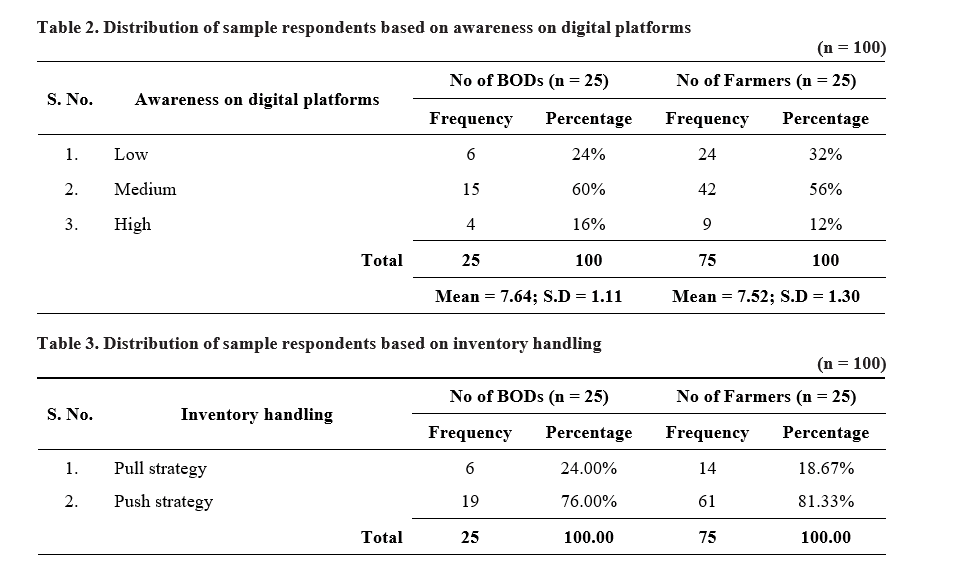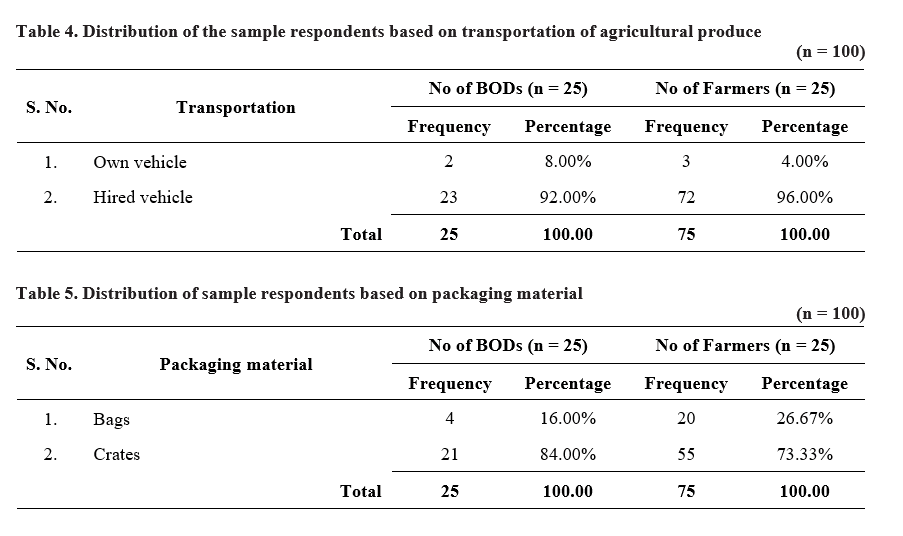Competencies and Infrastructure Requirements for Digital Marketing of Agricultural Produce by Fpos in Anantapur District
0 Views
G. HARI RAVINDRA GOUD*, N. KRISHNA PRIYA, N.T. KRISHNA KISHORE AND LAVANYA KUMARI
Institute of Agribusiness Management, S.V. Agricultural College, ANGRAU, Tirupati-517502.
ABSTRACT
In the era of globalisation and free trade liberalisation, it is imperative to develop rural entrepreneurship by implementing
the idea of collectivization or group initiation through local level organization. Indian farmers are capable of producing large quantities, but they struggle to sell their products at profitable prices due to lack of efficient technology, poor infrastructure and poor marketing structure. A potential alternative for effective marketing, information sharing, marketing and profit making is mobilising farmers for group action through developing farmer producer organisations which enables them to make decisions collectively for income enhancement. This helps the farmers go from merely producers of agricultural produce to sellers of the produce. In India, majority of farmers are small and marginal. There is a need to develop effective delivery system which fulfil the needs of small and marginal farmers. A suitable technology is required to improve sustainable food production and marketing for revenue enhancement.
KEYWORDS: Globalisation, Liberalisation, Marketing, Digital platforms.
INTRODUCTION
Agricultural sector plays an important role in both economic development and nation building. The contribution of GDP from agricultural sector had increased from 17.8 per cent (2019-20) to 19.9 per cent (2020-21). In India, 82 per cent of the farmers are having small to marginal land holdings. In order to reap the benefits of large scale farming by small and marginal farmers, it is very much necessary to give them access to better technology, finance, better inputs, and better markets. Keeping this in view, the Government of India has launched a scheme titled “Formation and Promotion of Ten Thousand FPOs” with a budgetary provision of 6,865 crores. The biggest obstacle in increasing farmers income in India are the profiteering middlemen, commission agents, traders and wholesalers take a major chunk of profit from farmers produce. This leaves very little for the farmers. The agricultural marketing plays a major role for getting better prices for the farmers. To solve these problems efficient marketing plays a very important role. Agricultural marketing activities are to create, explore and deliver quality products to the consumers. Agricultural marketing identifies the unfilled needs, desires and wants of the targeted customers. It will support the digital agriculture business and opportunities to sell and buy agricultural produce by farmers and consumers using digital platforms. Through these digital platforms, they may reach wide range of customers and they have different opportunities for the marketing of agricultural produce through B2B, B2C, B2B2C marketing channels. Reliance group, Bigbasket, Vegrow, Ninjacart, Waycool etc. are some of the digital platforms.
MATERIAL AND METHODS
Andhra Pradesh was selected purposively as the researcher belonged to this state. Anantapur district is having maximum number of FPOs and hence Anantapur district has been selected purposively. Out of ninety registered and functional FPOs in the district, five FPOs with maximum membership was selected purposively. The total sample size is 100 that constitute 25 board of directors and 75 farmer members. Primary as well as secondary data were collected to fulfill the designed objectives. The primary data was collected from farmers through the personal interview method by using a structured schedule. The secondary data regarding the agro-economic aspects of the study area were collected from the District Chief Planning Officer, Anantapur district.
RESULTS AND DISCUSSION
The analysis of the collected data revealed that most of the board of directors and farmers belonged to middle age group between 36 to 55 years with medium family size, most of the respondents pursued primary education and engaged in agriculture alone with small land holding. Medium level of annual income and mass media exposure with medium scientific orientation.
Competency and infrastructure requirement for digital marketing of agricultural produce
From the Table 1, we can conclude that 84 per cent of BODs did not have enough skill to operate the computer followed by 80 per cent of BODs said that sales process is lengthy and complex, 76 per cent of respondents were aware of uploading and grading of agricultural produce and 72 per cent of BODs cannot easily handle the process of digital marketing. With regard to farmers (92%) said that they did not have skill to operate the computer followed by 81.33 per cent of farmers cannot easily handle the process of digital marketing, 78.67 per cent farmers said that sales process is lengthy and complex and 70.67 per cent of respondents were aware of uploading and grading of agricultural produce.
Awareness on digital platforms
Table 2 revealed that 60 per cent of Board of Directors opinioned that by using of digital platforms market access may be increased, 24 per cent of respondents were less aware on digital platforms because transparency may or may not be increased, 16 per cent of BODs aware that by using of digital platforms volume of produce for sale may be increased.
Table 2 revealed that 56 per cent of respondent farmers aware using of digital platforms may increase in the price for the produce whereas 32 per cent of respondents expressed that quality produce may be exported by using digital platforms while 12 per cent of farmers expressed that value- added produce may get good price in digital platforms.
Inventory Handling
It is evident from the Table 3 that 76 per cent of Board of Directors of Five FPOs were following push strategy to handle the inventory and 24 per cent of BODs were following pull strategy to handle the inventory.
From the respondent farmers 81.33 per cent were following push strategy to handle the inventory and 18.67 per cent were following pull strategy to handle the inventory respectively.
Pull strategy initiates production as a reaction to present demand, while push strategy initiates production in anticipation of future demand.
Infrastructure Requirement
Poor infrastructure is available in five farmer producer organizations. None of the infrastructures is available in Five FPOs. This poor infrastructure can be a significant constraint for the storage and quality of the produce.
Transportation
Table 4 shows that 92 per cent of sampled board of directors transport their agricultural produce through hired vehicle on road while 8 per cent of sampled board of directors had own vehicle for transportation.
Table 1. Distribution of sample respondents based on competencies



In case of farmers 96 per cent of sampled farmers transport their agricultural produce through hired vehicles on road and 4 per cent of sampled farmers have own vehicles for transportation. Transportation of agriculture produce is generally carried out by tractors, lorry and Ashok Leyland.
Packaging material
From the table 5 it can be seen that majority (84%) of the respondents were using crates as packaging material for transporting agricultural produce while 16 per cent of Board of Directors were using bags as packaging material.
With regard to farmers, it can be inferred that more than one third (73.33%) of the members were using crates as packaging material for mango, tomato etc., whereas 26.67 per cent of farmers were using bags as packaging material for potato, citrus etc.
Competency revealed that majority of respondents did not have enough skill to operate the computer. The respondents were aware that that by using of digital platforms market access may be increased and price for the produce may be increased. The majority of respondents were following push strategy to handle the inventory. FPOs are not having adequate infrastructure facilities. Transportation revealed that majority of respondents transport their agricultural produce through hired vehicles. Packaging material revealed that majority of respondents using crates.
SUGGESTIONS
- Most of the FPOs have poor infrastructure So, it is necessary to improve infrastructure facilities.
- The present study was confined to competencies and infrastructure Further studies may be taken up on logistics, transportation costs and economic factors such as net savings and commodity prices.
- Most of the farmers are not aware of digital So, the government should organize awareness campaigns.
ACKNOWLEDGEMENT
I am very much grateful to the Institute of Agribusiness Management, Tirupati for the financial assistance provided in the form of a stipend during my post-graduate studies.
LITERATURE CITED
Barman, K and Devi, N. 2004. Infrastructure of agricultural marketing: A Study of three regulated markets in assam. Indian Journal of Agricultural Marketing, 18(3): 79.
Chahal, S and Kataria, P. 2008. Impact analysis of infrastructure and incentives on trade in regulated markets of Punjab. Agriculture Update. 3(3 & 4): 373-378.
Kaur, P and Kaur, A. 2003. Progress and performance of regulated markets in Punjab. Indian Journal of Agricultural Marketing. 17(1): 34-39.
Rai, K.N and Gangwar, A.C. 2000. The State of Agricultural Marketing in Haryana. Bihar Journal of Agricultural Marketing. 5(3): 288-295.
Sekhon, M.K and Rangi P.S. 2007. Marketing infrastructure for sustainable development- Role of Punjab Mandi Board. Indian Journal of Agriculture Marketing. 21: 110-120.
- Morphological Characterization of Sesame (Sesamum Indicum L.) Genotypes
- Effect of Liquid Biofertilizers on Productivity of Sesame (Sesamum Indicum L.)
- Profile Characteristics of Stakeholders in the Banana Value Chain: A Gender Analysis
- Studies on Genetic Variability and Genetic Parameters for Grain Yield and Its Components in Foxtail Millet (Setaria Italica (L.) P. Beauv.)
- Morphological Basis for Resistance Against Whitefly in Castor
- Dus Testing of Sesame (Sesamum Indicum L.) Accessions Using Morphological Descriptors

